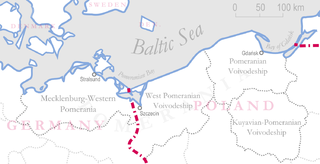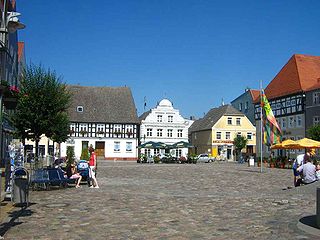
Pomerania is a historical region on the southern shore of the Baltic Sea in Central Europe, split between Poland and Germany. The western part of Pomerania belongs to the German states of Mecklenburg-Western Pomerania and Brandenburg, while the eastern part belongs to the West Pomeranian, Pomeranian and Kuyavian-Pomeranian voivodeships of Poland.

Szczecin is the capital and largest city of the West Pomeranian Voivodeship in northwestern Poland. Located near the Baltic Sea and the German border, it is a major seaport and Poland's seventh-largest city. As of December 2021, the population was 395,513.

Świnoujście is a city in Western Pomerania and seaport on the Baltic Sea and Szczecin Lagoon, located in the extreme north-west of Poland. Situated mainly on the islands of Usedom and Wolin, it also occupies smaller islands. The largest is Karsibór island, once part of Usedom, now separated by the Piast Canal, formerly the Kaiserfahrt, dug in the late 19th century to facilitate ship access to Szczecin.

The Dominions of Sweden or Svenska besittningar were territories that historically came under control of the Swedish Crown, but never became fully integrated with Sweden. This generally meant that they were ruled by Governors-General under the Swedish monarch, but within certain limits retained their own established political systems, essentially their diets. Finland was not a dominion, but an integrated part of Sweden. The dominions had no representation in the Swedish Riksdag as stipulated by the 1634 Instrument of Government paragraph 46: "No one, who is not living inside the separate and old borders of Sweden and Finland, have anything to say at Riksdags and other meetings..."

Police is a town in the West Pomeranian Voivodeship, in northwestern Poland. It is the capital of Police County and one of the biggest towns of the Szczecin agglomeration.

Goleniów is a town in Pomerania, northwestern Poland with 22,844 inhabitants (2011). It is the capital of Goleniów County in West Pomeranian Voivodeship ; previously it was in Szczecin Voivodeship (1975–1998). Town area is 12.5 square kilometres (4.8 sq mi), geographical situation 53°33'N and 14°49'E. It is situated in the centre of Goleniowska Forest on Goleniów Plain, near main roads numbers 3 and 6.

Sławno is a town on the Wieprza river in Middle Pomerania region, north-western Poland, with 12,511 inhabitants (2019). It is the administrative seat of Gmina Sławno, though not part of it. The town is also the capital of Sławno County in West Pomeranian Voivodeship since 1999, previously in Słupsk Voivodeship (1975–1998).

Drawsko Pomorskie is a town in the West Pomeranian Voivodeship, in northwestern Poland. It is the administrative seat of Drawsko County and the urban-rural commune of Gmina Drawsko Pomorskie. As of December 2021, the town has a population of 11,292. It is home to the Drawsko Training Ground, one of the largest training areas in Poland.

The History of Szczecin dates back to the 8th century. Throughout its history the city has been part of Poland, Denmark, Sweden and Germany. Since the Middle Ages, it is one of the largest and oldest cities in the historic region of Pomerania, and today, is it the largest city in northwestern Poland.

The history of Pomerania starts shortly before 1000 AD, with ongoing conquests by newly arrived Polans rulers. Before that, the area was recorded nearly 2000 years ago as Germania, and in modern times Pomerania is split between Germany and Poland. Its name comes from the Slavic po more, which means "land at the sea".

Farther Pomerania, Hinder Pomerania, Rear Pomerania or Eastern Pomerania, is the part of Pomerania which comprised the eastern part of the Duchy and later Province of Pomerania. It stretched roughly from the Oder River in the West to Pomerelia in the East. Since 1945, Farther Pomerania has been part of Poland; the bulk of former Farther Pomerania is within the West Pomeranian Voivodeship, while its easternmost parts are within the Pomeranian Voivodeship. The Polish term Pomorze Zachodnie is colloquially used in contemporary Poland as a synonym for the West Pomeranian Voivodship whose borders do not match the historical ones; in Polish historical usage, it applied to all areas west of Pomerelia.

Ueckermünde is a seaport town in northeast Germany, located in the district of Vorpommern-Greifswald, Western Pomerania, near Germany's border with Poland's Police County.

The Province of Pomerania was a province of Prussia from 1815 to 1945. Pomerania was established as a province of the Kingdom of Prussia in 1815, an expansion of the older Brandenburg-Prussia province of Pomerania, and then became part of the German Empire in 1871. From 1918, Pomerania was a province of the Free State of Prussia until it was dissolved in 1945 following World War II, and its territory divided between Poland and Allied-occupied Germany. The city of Stettin was the provincial capital.
Treaty of Stettin (Szczecin) may refer to:

Pomerania during the Early Modern Age covers the history of Pomerania in the 16th, 17th, and 18th centuries.

The Province of Pomerania was a province of Brandenburg-Prussia, the later Kingdom of Prussia. After the Thirty Years' War, the province consisted of Farther Pomerania. Subsequently, the Lauenburg and Bütow Land, Draheim, and Swedish Pomerania south of the Peene river were joined into the province. The province was succeeded by the Province of Pomerania set up in 1815.

History of Pomerania (1806–1933) covers the history of Pomerania from the early 19th century until the rise of Nazi Germany.

The Oder is a river in Central Europe. It is Poland's second-longest river in total length and third-longest within its borders after the Vistula and Warta. The Oder rises in the Czech Republic and flows 742 kilometres (461 mi) through western Poland, later forming 187 kilometres (116 mi) of the border between Poland and Germany as part of the Oder–Neisse line. The river ultimately flows into the Szczecin Lagoon north of Szczecin and then into three branches that empty into the Bay of Pomerania of the Baltic Sea.

Historical Western Pomerania, also called Cispomerania,Fore Pomerania, Front Pomerania or Hither Pomerania, is the western extremity of the historic region of Pomerania forming the southern coast of the Baltic Sea. Western Pomerania's boundaries have changed through the centuries as it belonged to various countries such as Poland, the Duchy of Pomerania, Sweden, Denmark, as well as Prussia which incorporated it as the Province of Pomerania.















